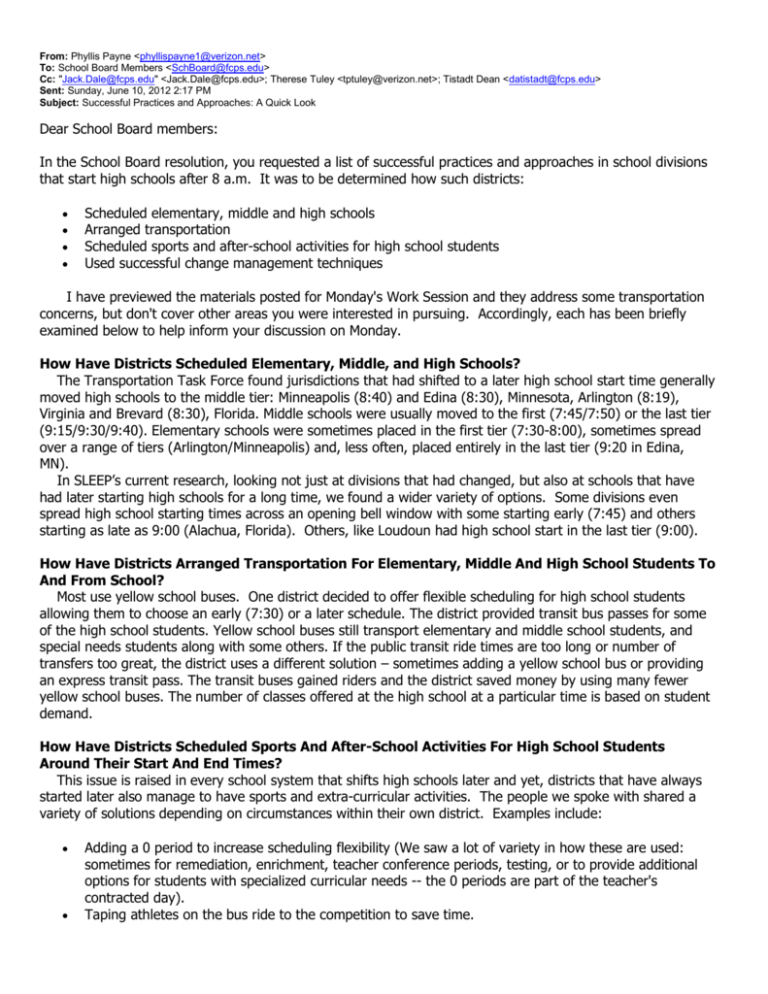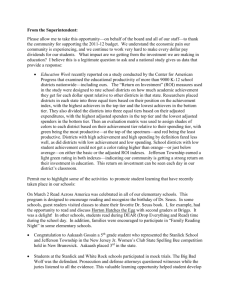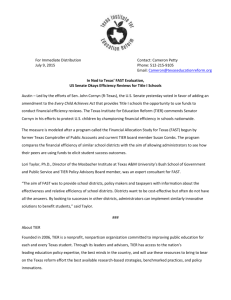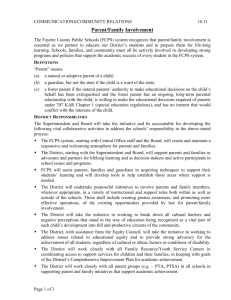Change Management and Elements of Success 6.10.12
advertisement

From: Phyllis Payne <phyllispayne1@verizon.net> To: School Board Members <SchBoard@fcps.edu> Cc: "Jack.Dale@fcps.edu" <Jack.Dale@fcps.edu>; Therese Tuley <tptuley@verizon.net>; Tistadt Dean <datistadt@fcps.edu> Sent: Sunday, June 10, 2012 2:17 PM Subject: Successful Practices and Approaches: A Quick Look Dear School Board members: In the School Board resolution, you requested a list of successful practices and approaches in school divisions that start high schools after 8 a.m. It was to be determined how such districts: Scheduled elementary, middle and high schools Arranged transportation Scheduled sports and after-school activities for high school students Used successful change management techniques I have previewed the materials posted for Monday's Work Session and they address some transportation concerns, but don't cover other areas you were interested in pursuing. Accordingly, each has been briefly examined below to help inform your discussion on Monday. How Have Districts Scheduled Elementary, Middle, and High Schools? The Transportation Task Force found jurisdictions that had shifted to a later high school start time generally moved high schools to the middle tier: Minneapolis (8:40) and Edina (8:30), Minnesota, Arlington (8:19), Virginia and Brevard (8:30), Florida. Middle schools were usually moved to the first (7:45/7:50) or the last tier (9:15/9:30/9:40). Elementary schools were sometimes placed in the first tier (7:30-8:00), sometimes spread over a range of tiers (Arlington/Minneapolis) and, less often, placed entirely in the last tier (9:20 in Edina, MN). In SLEEP’s current research, looking not just at divisions that had changed, but also at schools that have had later starting high schools for a long time, we found a wider variety of options. Some divisions even spread high school starting times across an opening bell window with some starting early (7:45) and others starting as late as 9:00 (Alachua, Florida). Others, like Loudoun had high school start in the last tier (9:00). How Have Districts Arranged Transportation For Elementary, Middle And High School Students To And From School? Most use yellow school buses. One district decided to offer flexible scheduling for high school students allowing them to choose an early (7:30) or a later schedule. The district provided transit bus passes for some of the high school students. Yellow school buses still transport elementary and middle school students, and special needs students along with some others. If the public transit ride times are too long or number of transfers too great, the district uses a different solution – sometimes adding a yellow school bus or providing an express transit pass. The transit buses gained riders and the district saved money by using many fewer yellow school buses. The number of classes offered at the high school at a particular time is based on student demand. How Have Districts Scheduled Sports And After-School Activities For High School Students Around Their Start And End Times? This issue is raised in every school system that shifts high schools later and yet, districts that have always started later also manage to have sports and extra-curricular activities. The people we spoke with shared a variety of solutions depending on circumstances within their own district. Examples include: Adding a 0 period to increase scheduling flexibility (We saw a lot of variety in how these are used: sometimes for remediation, enrichment, teacher conference periods, testing, or to provide additional options for students with specialized curricular needs -- the 0 periods are part of the teacher's contracted day). Taping athletes on the bus ride to the competition to save time. Adding lights to the fields and tennis courts (some used mobile lights that could be moved depending on season and venue). Holding some practices before school (especially popular in Texas where many high schools start at 9:00) Scheduling athletes in a PE class at the end of the day and releasing them early to go to competitions/games. Releasing students early on game days Replacing after-school remediation with during school (e.g., lunch) or before school help (reported that teachers preferred this to having to stay after school), so athletes could proceed directly to practice instead of having a gap between dismissal and practice. A former school board member from one district advised that it is important to focus on the nitty-gritty details—to follow students to band practice, to football, to swim, etc. and to see what the current routine entails. By doing this, her district was able to develop solutions to the logistical conflicts that arose from the later dismissal time. Their focus was to meet the needs of the largest number of students first and to resolve other scheduling conflicts with a view to “not every student and not every day.” In other words, if one team of athletes needed to wake early for practices, this was considered a worthwhile trade-off because the vast majority of students were better served, and even the athletes wouldn't have to wake early every day of the year. (Even with our existing early schedule, we have some athletes practicing some sports before school.) Change Management Techniques and Common Elements of Success: Communication: One theme seems to be a focus on increasing awareness among stakeholders to ensure that the community is aware of the benefits of this change to the health, well-being, and learning of our children. Time: Lead time is important to a smooth transition. Options: It’s important to bring more than one potential plan to the community and to incorporate community input and suggestions along the way and to revise the options to attempt to address concerns. Problem-solving: Identify concerns and investigate potential solutions. One district wrote an “Issue” paper for each issue that was identified providing a detailed proposed solution. Plans to study the results are helpful because then there is feedback about what is working well and what could be improved. Leadership from the Superintendent, the school board, and sometimes help from champions within the community. Change is hard and smooth transitions require leadership, communication, collaboration, creativity, and critical thinking (problem-solving). There isn't just one solution to the logistical challenge of scheduling later, healthier high school start times. There are many solutions. Studies show that later high school start times bring meaningful improvement to our high school students' quality of life and improve their academic performance. Other districts with later start times have shown that students' access to after-school or pre-school activities do not suffer. FCPS, too, can make this happen. Best, Phyllis Payne, MPH SLEEP Co-founder www.sleepinfairfax.org




